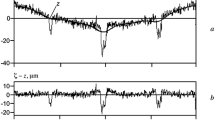Abstract
The estimation of the surface-layer parameters u * (friction velocity), θ* and q * (temperature and humidity scales), θ r and q r (temperature and humidity reference values), z o (roughness length) and d (zero-displacement) from vertical profiles of wind velocity, temperature and humidity by least-squares methods is described. The estimation is based on the flux-gradient relationships and the constant flux assumption for the transfer of momentum, sensible heat and matter near the Earth's surface.
Test calculations were carried out with the vertical profile data from the GREIV I 1974 experiment and the Great Plains Turbulence Project.
Similar content being viewed by others
References
Beyer, R. and Roth, R.: 1976, ‘GREIV I 1974-Meβdaten’, Berichte d. Inst. f. Meteor. u. Klimat. d. TU Hannover 16.
Businger, J. A.: 1973, ‘Turbulent Transfer in the Atmospheric Surface Layer’, in D. A. Haugen (ed.), Workshop on Micrometeorology, Amer. Meteorol. Soc., Boston, 67–100.
Dyer, A. J. and Hicks, B. B.: 1970, ‘Flux-Gradient Relationships in the Constant Flux layer. Quart. J. R. Meteorol. Soc. 96, 715–721.
Lettau, H. H. and Davidson, B.: 1957. Exploring the Atmosphere's First Mile, Vols. 1 and 2, Pergamon Press, New York, p. 201.
Kramm, G. and Herbert, F.: 1984, ‘Ein numerisches Modell zur Deposition von Schadstoffen in der bodennahen Luftschicht’, in H. Reuter (ed.), Probleme der Umwelt- und Medizinmeteorologie im Gebirge, Symposium Rauris/Austria, 23–25 Sept. 1983, Zentralanstalt f. Meteorologie u. Geodynamik, Wien, Nr. 288.
Kramm, G.: 1989, ‘A Numerical Method for Determining the Dry Deposition of Atmospheric Trace Gases’, Boundary-Layer Meteorol. 48, 157 (this volume).
Lo, A. K.: 1977, ‘An Analytical-Empirical Method for Determining the Roughness Length and Zero-Plane Displacement’, Boundary-Layer Meteorol. 12, 141–151.
Monin, A. S. and Obukhov, A. M.: 1958, ‘Fundamentale Gesetzmäβigkeiten der turbulenten Vermischung in der bodennahen Schicht der Atmosphäre’, in H. Goering (ed.), Sammelband zur statistischen Theorie der Turbulenz, Akademie Verlag, Berlin, p. 228.
Nieuwstadt, F.: 1978, ‘The Computation of the Friction Velocity u * and the Temperature Scale T * from Temperature and Wind Velocity Profiles by Least-Square Methods’, Boundary-Layer Meteorol. 14, 235–246.
Panofsky, H. A. and Brier, G. W.: 1968, Some Applications of Statistics to Meteorology, Penn State University.
Panofsky, H. A. and Dutton, J. A.: 1984, Atmospheric Turbulence, John Wiley & Sons, New York/Chichester/Brisbane/Toronto/Singapore, p. 397.
Paulson, C. A.: 1970, ‘The Mathematical Representation of Wind Speed and Temperature Profiles in the Unstable Atmospheric Surface Layer’, J. Appl. Meteorol. 9, 857–861.
Stearns, C. R.: 1970, ‘Determining Surface Roughness and Displacement Height’, Boundary-Layer Meteorol. 1, 102–111.
Stoer, J.: 1972, Einführung in die numerische Mathematik I, Springer, Berlin/Heidelberg/New York/Tokyo, p. 250.
Webb, E. K.: 1970, ‘Profile Relationships: The Log-Linear Range, and Extension to Strong Stability’, Quart. J. R. Meteorol. Soc. 96, 67–90.
Author information
Authors and Affiliations
Rights and permissions
About this article
Cite this article
Kramm, G. The estimation of the surface-layer parameters from wind velocity, temperature and humidity profiles by least-squares methods. Boundary-Layer Meteorol 48, 315–327 (1989). https://doi.org/10.1007/BF00158331
Accepted:
Issue Date:
DOI: https://doi.org/10.1007/BF00158331




